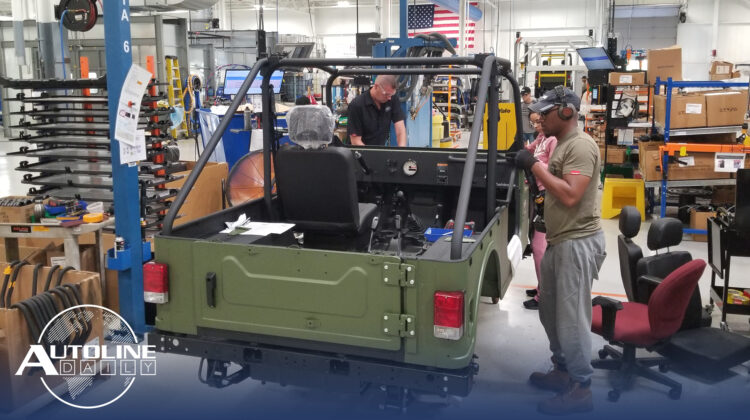
Follow us on social media:
Runtime: 12:52
0:07 EV Batteries Could Create Tons of Waste
0:46 Lincoln Aviator’s Heated Wiper Blades
1:39 Hyundai’s New Engine Technology
2:35 Toyota Makes Patents Available to Anyone
4:00 Tesla Model 3 Power Upgrade
5:00 BMW i3 Urban Suite
5:41 Are eScooters Helping to Reduce Congestion?
7:32 Honda Introduces New Electric Scooter
8:04 Honda Hits Motorcycle Milestone
8:31 Sneak Peek into The ROXOR Assembly Process
Visit our sponsor to thank them for their support of Autoline Daily: Bridgestone.
Welcome to the last Autoline Daily for 2019. And now the news.
EV BATTERIES COULD CREATE TONS OF WASTE
Electric cars are touted as saviors of the planet, but a group of scientists are warning that EV batteries could become a major contributor of e-waste unless they can be fully recycled. In a lengthy article posted in the publication Nature, they say that the EV batteries that were made in 2017 could create 250,000 metric tons and half a million cubic meters of waste. They say that re-use and some recycling could reduce this waste but the growth in EVs could overwhelm those efforts, and they call for more efforts to figure out how to recycle those batteries.
LINCOLN AVIATOR’S HEATED WIPER BLADES
Scraping snow and ice off your windshield can be a big pain in the butt on a cold winter morning, that’s why the all-new Lincoln Aviator is available with heated wiper blades so you don’t have to worry about that. Unlike traditional systems that spray fluid through nozzles in front of the windshield, Lincoln’s system dispenses wiper fluid through integrated nozzles on the blade, and uses up to 50% less fluid. It can take defrosters up to 15 minutes to melt ice off a windshield but the wiper blades on the Aviator feature an integrated heating element that can heat from sub-freezing temperatures to 86 degrees Fahrenheit in four minutes. So not only is it a time saver, you also don’t have to worry about taking time to clear the windshield out in the cold.
HYUNDAI’S NEW ENGINE TECHNOLOGY
Hyundai has achieved something of a breakthrough in valve technology for piston engines. While many automakers have variable valve timing, which affects when the valves open and close, Hyundai developed a system that affects how long the valve stays open. They call it continuously variable valve duration and it debuts on the 1.6-liter turbo going into the new Sonata. It improves fuel economy 5%, adds 4% more power and cuts emissions 12%. At constant engine speeds, it leaves the intake valve open longer to reduce resistance from compression. That boosts fuel efficiency. At high speeds, it shuts the valve at the beginning of the compression stroke to maximize the amount of air for the explosion, which boosts torque and acceleration. Hyundai’s valve system is incredibly complicated, but it gets the job done.
TOYOTA MAKES PATENTS AVAILABLE TO ANYONE
Toyota is sitting on a ton of patents and figured it’s time to make money on them. So it launched Toyota IP Solutions to license those patents to anyone who wants to use them, especially outside of the automotive industry. Specifically, it’s offering patents in Omnidirectional Structural Color, Bio-Active Material, Nano-Material Synthesis, and Electronics Thermal Management. Let’s translate: omnidirectional structural color involves pigment compounds capable of reflecting specific wavelengths of light. The bio-active material involves enzymes that break down organic materials, making stains and spills easier to clean. The nano-materials are for extremely high-quality battery electrodes and strong magnets with no rare-earth materials. And the last one showcases cooling strategies that can be integrated into power-dense electronics to dissipate heat. Interestingly, Toyota IP solutions is being run out of its North American headquarters in Texas.
TESLA MODEL 3 POWER UPGRADE
If you wanted to drop the 0 to 60 time of your car by half a second, it would probably take a bunch of time and money. But times, they are a changin’. Highlighting another benefit of over-the-air updates, Tesla is offering an upgrade for dual motor Model 3’s with software version 2019.40.2 or newer that will reduce 0 to 60 MPH time from 4.4 seconds to 3.9. The update will cost owners $2,000. And while it’s only available for dual motor 3’s right now, there’s evidence it will also be offered for long-range, rear-drive versions as well. This raises a few interesting questions for me, would you pay the $2,000 and would or does it bother you that your vehicle won’t let you tap into its full potential, even though it already has the proper equipment and you’ve paid for it? I can understand the good and bad arguments for both and I’m interested to get a better idea where you all stand.
BMW i3 URBAN SUITE
Consumers have the choice of any vehicle they could possibly need, from econ-o-boxes to plush luxury saloons. And it will be the same for any mobility solution that’s offered in the future. While the BMW i3 might not scream luxury, the interior of its Urban Suite concept certainly does. This is BMW’s vision for future mobility. It completely gutted the interior of an i3, save the driver’s seat and dashboard, and added a large, plush seat with a footrest, a flip-down screen and a personal sound zone. BMW will display the i3 Urban Suite at CES in January.
ARE eSCOOTERS HELPING TO REDUCE CONGESTION?
A few years ago, electric scooters began popping up, seemingly out of nowhere, in many cities across the U.S. That sudden influx was even lampooned on an episode of South Park. So are these eScooters helping to reduce traffic congestion? On Autoline This Week, Annie Chang, the Head of New Mobility at SAE International, answered that question.
Annie Chang, Head of New Mobility, SAE International
“I think that is an open question. I don’t think there’s enough data or research done to understand where the demand is coming from. There were no scooters two to three years ago, so where are these trips coming from? Are they coming from walking trips or are they coming from single occupancy vehicles, shifting over to micro mobility? It’s very unclear at this time. And when we look at the trip distribution, it’s 81% of trips made on e-bikes in Washington D.C. is less than two miles, 91% for scooters. So they’re very, very short trips. So we can understand that most them are coming from walking trips. So does that help traffic, not necessarily. But as the vehicle design changes, it may help. If the vehicle’s get more comfortable for longer rides, the battery range improves, if you can start putting stuff, material load on the scooter instead of just yourself, maybe you can use it for more utilitarian purposes. Instead of just social, recreational use.”
For more about the growth of eScooters and micro mobility, you can watch that entire show right now on our website, Autoline.tv or you can find it on our YouTube channel.
HONDA INTRODUCES NEW ELECTRIC SCOOTER
And while we’re on that subject, Honda is introducing the BENLY e:, an electric scooter for delivery services in Japan. The bike is available with a large front basket and rear carrier and is powered by two swappable Mobile Power Packs, which provide up to 87 kilometers or about 54 miles of range. Interestingly, Honda only plans to make about 200 a year and will only sell them to corporate customers who agree to cooperate in the collection of used batteries.
HONDA HITS MOTORCYCLE MILESTONE
Honda is one of the world’s best-known motorcycle manufacturers and it just hit a major milestone. Honda has now cleared the 400-million-unit mark. It all started back in 1949 with the Dream D-Type and today Honda makes motorcycles in 21 countries.
SNEAK PEEK INTO THE ROXOR ASSEMBLY PROCESS
Going into an automotive assembly plant is an awesome experience, if for nothing less than seeing what it takes to put a car together. But those places can be huge with massive sheet metal presses, vehicles passing from one building to another and parts flying overhead. And while Mahindra North America might have to cease ROXOR production soon, a recent trip through its facility in Auburn Hills, Michigan was a great way to experience vehicle manufacturing. Since the vehicle is not very complex, it was such an easy process to follow.
Here, I’ll take you through what it takes to make a ROXOR. We’ll start with crates of body panels from India that get unpacked. Many of the ROXOR’s parts come from India, including frames and axles, but a good portion of its components are sourced in North America as well. The various body panels are fixed to a roll around cart that allows them to be easily moved. The first stop is the paint booth.
To make this part of the process as efficient as possible they’re painted in batches of the same color. But with the entire PPG paint catalog to choose from, there’s a nearly endless amount of combinations to choose from. And Mahindra can easily slide a custom color into the line.
Once paint is cured, the body rolls into another booth where a spray-in bed liner is applied to the inside of the cabin on ever Roxor, but if a customer so chooses they can have it put on the entire vehicle and that includes the outside of body panels. From there it’s a straight shot to the next phase, where the roll cage, part of the wiring harness, control pedals, steering column, battery, brake master cylinder and slave cylinder, if it’s a manual, are all installed. While all of that is being done, the frame is dressed with its components.
Here’s where axles, brakes, fuel tank, brake and fuel lines, engine, which is a 2.3L 4-cylinder diesel, transmission, either a manual or automatic, drive shaft and exhaust come in. So, now we’re at a point where the body and chassis are mostly dressed and it’s time to marry the two together. Fixed guides help aid the alignment and there’s less than 20 bolts hold them together, so it’s not a long or very complicated process. This is also the time when a few things get buttoned up under the hood. As it moves forward, the seats, fenders, hood, radiator, wheels and tires and other bits and pieces finish up the assembly process.
The final step is a trip to the dyno before the vehicles head off for shipping
Boom! And now you’ve got a ROXOR. It’s pretty easy to follow and It was really cool to see one automaker’s approach to niche manufacturing. Workers are able to churn out about 20 of them a day. And if Mahindra doesn’t have to stop production, due to its legal battle with FCA, we think it may have to increase output. We’ll dive into that after the holiday break.
To wrap up today’s show, we wanted to take a moment to thank YOU, our loyal viewers, for taking the time out of each day to watch or listen to Autoline. We truly enjoy creating content for those who are just as passionate about this wild, ever-evolving industry as we are. Let us know in the comments or send us an email to tell us which topics you’d like to see covered next year!
Thank you again, and we’ll see you in the new decade on January 3!
Thanks to our partner for embedding Autoline Daily on its website: WardsAuto.com

John McElroy is an influential thought leader in the automotive industry. He is a journalist, lecturer, commentator and entrepreneur. He created “Autoline Daily,” the first industry webcast of industry news and analysis.





